Articles
- Page Path
- HOME > J Korean Acad Nurs > Volume 42(7); 2012 > Article
-
Original Article
- Outcomes-based Curriculum Development and Student Evaluation in Nursing Education
- Hesook Suzie Kim
-
Journal of Korean Academy of Nursing 2012;42(7):917-927.
DOI: https://doi.org/10.4040/jkan.2012.42.7.917
Published online: December 12, 2012
College of Nursing, University of Rhode Island, Kingston, Rhode Island, USA
College of Nursing, University of Rhode Island, Kingston, Rhode Island, USA
- Address reprint requests to : Kim, Hesook Suzie College of Nursing, University of Rhode Island, Kingston, Rhode Island, 5421 Rodriquez Lane, Haymarket, VA 20169 USA Tel: +1-571-261-5495 E-mail: hsuziekim@comcast.net
• Received: November 4, 2012 • Accepted: November 29, 2012
Copyright © 2012 Korean Society of Nursing Science
This is an Open Access article distributed under the terms of the Creative Commons Attribution Non-Commercial License (http://creativecommons.org/licenses/by-nc/3.0) which permits unrestricted non-commercial use, distribution, and reproduction in any medium, provided the original work is properly cited.
- 1,264 Views
- 27 Download
- 22 Crossref
Abstract
-
Purpose
- A curriculum development model is presented to examine the processes necessary to develop new programs or evaluate existing programs within the philosophy of outcomes-based education in nursing, especially in the context of accreditation. The philosophy of outcomes-based education is to produce individuals who can demonstrate the evidence of competencies in designated areas of education. For nursing education, this means competencies in performing the role of professional nursing as defined by the profession and social needs at the beginning level upon completing a nursing program.
-
Methods
- A curriculum development model has been developed analytically based on the literature and experiences.
-
Results
- A 10-step process framework incorporating the tenets of outcomes-based nursing education is illustrated.
-
Conclusion
- This curriculum development framework can be applied in developing new educational programs in nursing or to evaluate and revise existing programs in anticipation of the accreditation process that is moving with a full force in such countries as Korea.
Figure 4.The frame of curriculum development representing the standards of Commission on Collegiate Nursing Education.
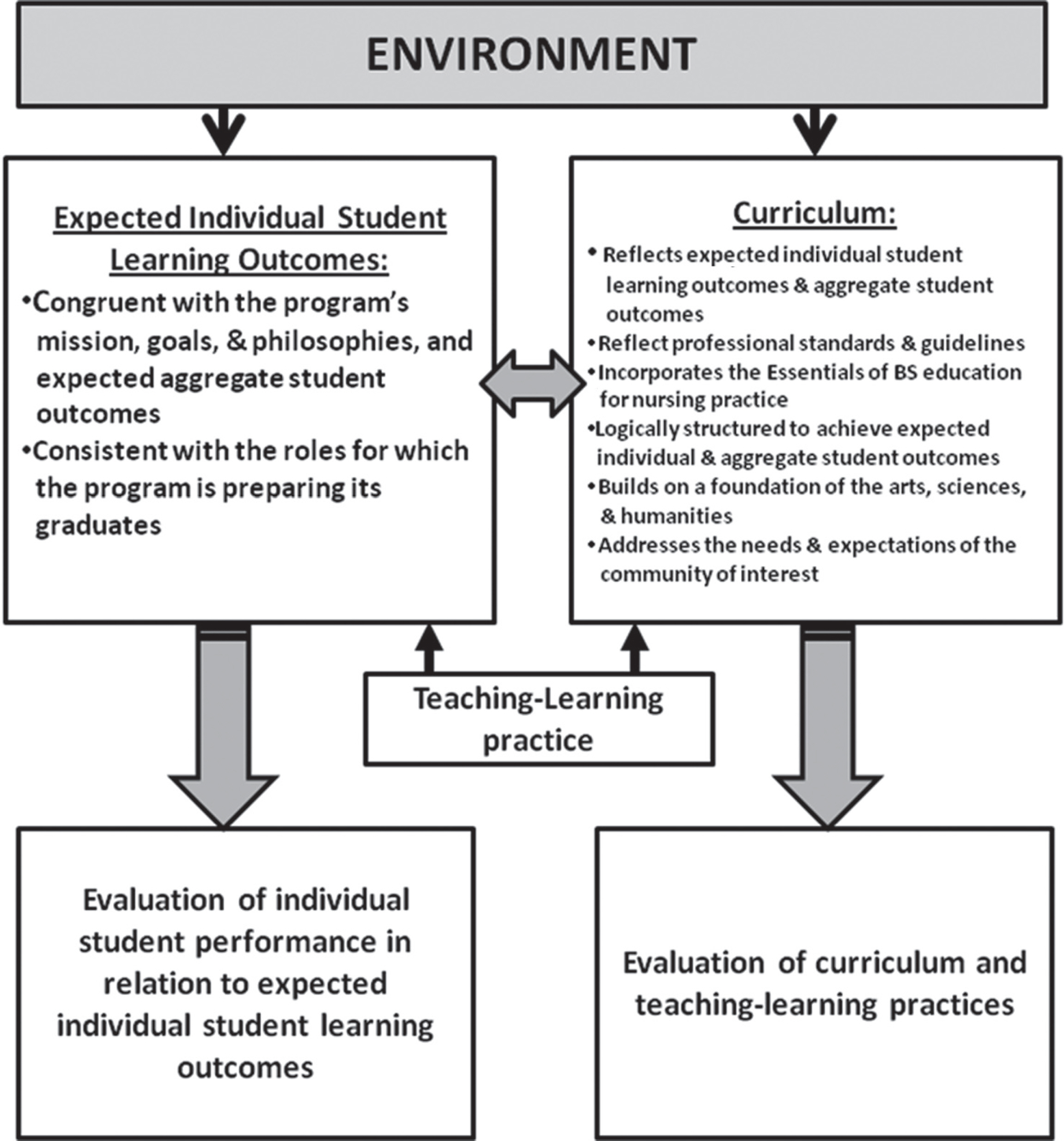

Figure 5.A matrix (an example) for delineation of critical contents for nursing curriculum applying a system of content type.
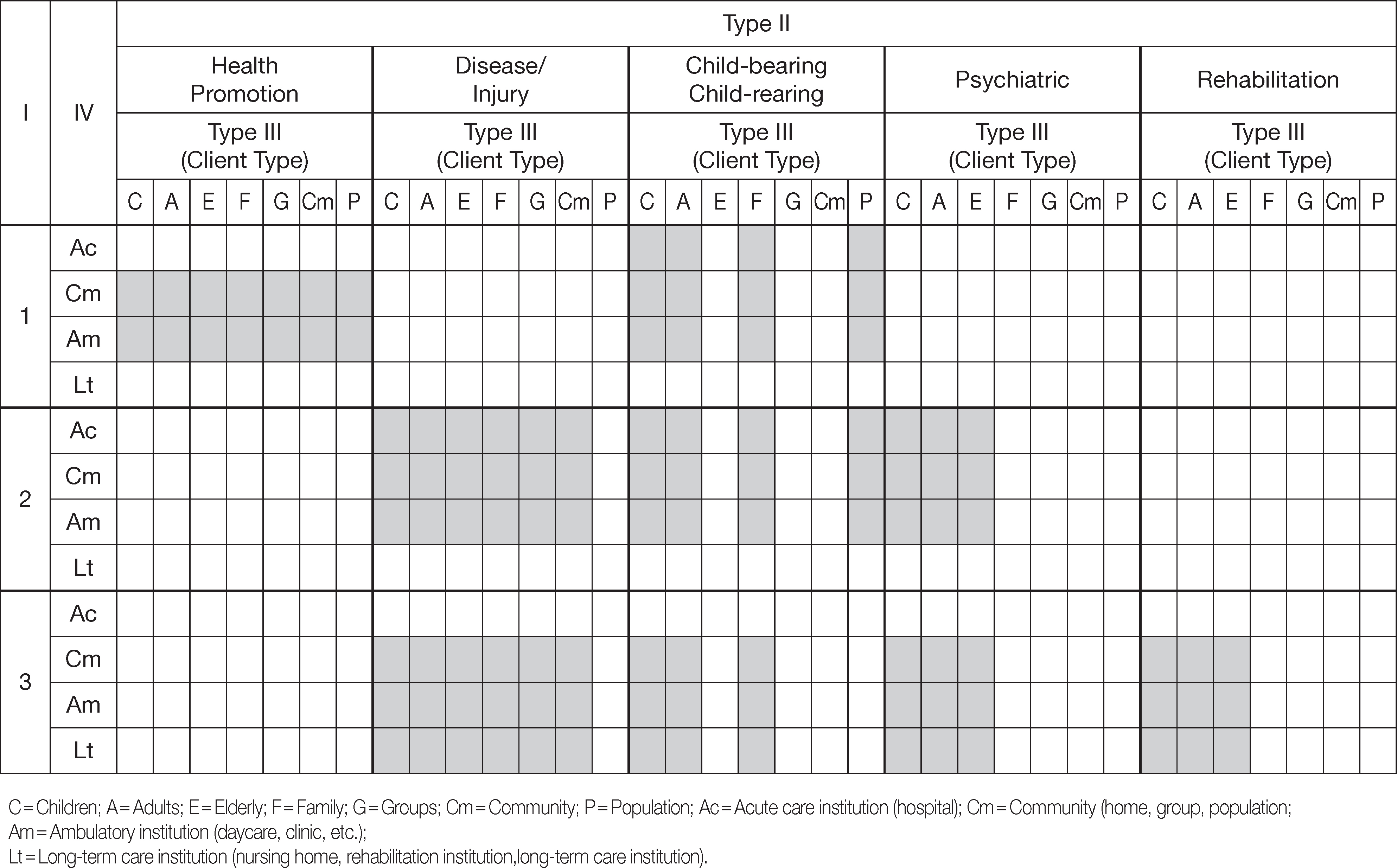

- American Association of Colleges of Nursing. 2008.The essentials of baccalaureate education for professional nursing practice. Washington, DC: Author.
- American Nurses Association. 2010.Nursing: Scope and standards of practice. 2nd ed.Washington, DC: Author.
- Bloom B. S., Hastings J. T., Madaus G. G.. 1971.Handbook on formative and summative evaluation of student learning. New York: McGraw-Hill.
- Commission on Collegiate Nursing Education. 2009.Standards for accreditation of baccalaureate and graduate degree nursing programs. Washington, DC: Author.
- Cronenwett L., Sherwood G., Barnsteiner J., Disch J., Johnson J., Mitchell P., et al. 2007;Quality and safety education for nurses. Nursing Outlook. 55:122–131. http://dx.doi.org/10.1016/j.outlook.2007.02.006ArticlePubMed
- Finkelman A., Kenner, C. 2009.Professional nursing concepts: Competencies for quality leadership. Sudbury, MA: Jones and Bartlett Publishers.
- Frenk J., Chen L., Bhutta Z., Cohen J., Crisp N., Evans T., et al. 2010;Health professionals for a new century: Transforming education to strengthen health systems in an interdependent world. Lancet. 376:1923–1958. http://dx.doi.org/10.1016/S0140-6736(10)61854-5ArticlePubMed
- Greiner A. C., Knebel, E. 2003.Health professions education: A bridge to quality. Washington, DC: National Academies Press.
- Hsu L. L., Hsieh S.I. 2012;Development and psychometric evaluation of the competencyinventory for nursing students: A learning outcome perspective. Nurse Education Today. http://dx.doi.org/10.1016/j.nedt.2012.05.028Article
- Institute of Medicine. 2000.To err is human: Building a safer health system. Washington, DC: Author.
- Institute of Medicine. 2003.Health professions education: A bridge to quality. Washington, DC: Author.
- International Council on Nursing. 2004.Position statement: Scope of nursing practice. Geneve, Switzerland: Author.
- Jones E., Voorhees R., Paulson, K. 2002.Defining and assessing learning: Exploring competency-based initiatives. Washington, DC: Council of the National Postsecondary Education Cooperative.
- Korean Accreditation Board of Nursing Education. 2012.The standards of accreditation for nursing education. Seoul: Author.
- Lenburg C. B., Klein C., Abdur-Rahman V. A., Spencer T., Boyer, S. 2009;THE COPA MODEL: A comprehensive framework designed to promote quality care and competence for patient safety. Nursing Education Perspectives. 30:312–317.PubMed
REFERENCES
Figure & Data
REFERENCES
Citations
Citations to this article as recorded by 

- Evaluating undergraduate nursing education and student competencies: a mixed-methods study using the input- process- output framework
Menevse Yildirim, Melek Sahin
BMC Nursing.2025;[Epub] CrossRef - Keeping Up with the Outcomes-Based Education Trends in Nursing Education and Practice Among Professionals in the National Capital Regiona Dissertation Conferred in January 2024
Joan O. Ranada, Lily Famadico
International Journal of Multidisciplinary Applied Business and Education Research.2025; 6(7): 3661. CrossRef - Flipped Classroom Based on Outcomes-Based Education Improves Student Engagement and Clinical Analysis Competence in Undergraduates Ophthalmology Clerkship
Qing Liu, Xiao-Jiao Tang, Xin-Ke Chen, Lin Chen
Advances in Medical Education and Practice.2024; Volume 15: 599. CrossRef - Hemşirelik Eğitim Programlarında “Kara Kutu”nun Açılması: Logic Model Örneği
Gülsüm Çonoğlu, Fatma Orgun
Avrasya Sağlık Bilimleri Dergisi.2024; 7(3): 251. CrossRef - The effect of outcome-based education on clinical performance and perception of pediatric care of the third-year nursing students in Mongolia
Khishigdelger Lkhagvaa, Basbish Tsogbadrakh, Gankhuyag Gochoosuren, Oyungoo Badamdorj, Azadeh Stark, Omar Mohammad Ali Khraisat
PLOS ONE.2024; 19(6): e0305298. CrossRef - Development and implementation of a high-fidelity simulation training course for medical and nursing collaboration based on the Fink integrated course design model
Meng-Han Jiang, Li-Wen Dou, Bo Dong, Man Zhang, Yue-Ping Li, Cui-Xia Lin
Frontiers in Medicine.2024;[Epub] CrossRef - Experiences and attitudes of clinical and academic nurses about infection prevention and control nursing curriculum and duties - a qualitative study
Zahra Gorjian, Marziyeh Asadizaker, Kourosh Zarea, Alireza Irajpour, Fatemeh Ahmadi, Dariush Rokhafroz
BMC Medical Education.2024;[Epub] CrossRef - Transcultural adaptation and validity of the nurse professional competence scale Korean version for graduating nursing students: An explanatory factor analysis
Su Jung Lee, Hyun‐Ju Seo, Kye Ha Kim, Jinhee Kim, Hyunlye Kim, Jeong‐Min Park
Nursing Open.2023; 10(2): 579. CrossRef - Oral health education in the undergraduate nursing curriculum of Australian and Malaysian institutions
Mas S. Ahmad, Menaka A. Abuzar, Ishak A. Razak, Sabariah A. Rahman, Gelsomina L. Borromeo
European Journal of Dental Education.2021; 25(2): 350. CrossRef - Effects of a Simulation With Team-Based Learning on Knowledge, Team Performance, and Teamwork for Nursing Students
Young Sook Roh, Sang Suk Kim, Sunah Park, Jung-Won Ahn
CIN: Computers, Informatics, Nursing.2020; 38(7): 367. CrossRef - Understanding gaps and needs in the undergratue nursing curriculum in Iran: A prelude to design a competency-based curriculum model
Sepand Riazi, Nahid Dehghannayeri, Ali Hosseinikhah, Majid Aliasgari
Health Monitor Journal of the Iranian Institute for Health Sciences Research.2020; 19(2): 145. CrossRef - A study to determine the educational objectives and outcomes for pre-registration Diploma nursing program: A modified Delphi
Katherine Tan, Mei Chan Chong, Li Ping Wong
Nurse Education in Practice.2019; 39: 80. CrossRef - Effect of a Situational Module Learning Course on Critical Thinking Disposition and Metacognition in Nursing Students: A Quasi-experimental Study
Kwang Ok Park, Mi Yu
Journal of Korean Academic Society of Nursing Education.2019; 25(2): 251. CrossRef - Preliminary study of outcome‐based clinical practicum for undergraduate nursing students
Kyunghwa Lee, Sanghee Kim, You Lee Yang
Japan Journal of Nursing Science.2019; 16(2): 145. CrossRef - Investigating Factors Affecting Pharmaceutical Care Learning in Clinical Education in the View of Nursing Students in 2016 - 2017
Ellnaz Yazdan Parast, Bahare Rezvani Dehaghani, Sahar Nadimi, Seyed Hassan Ghorbani, Malihe Davoudi
Modern Care Journal.2018;[Epub] CrossRef - The effectiveness of outcome based education on the competencies of nursing students: A systematic review
Katherine Tan, Mei Chan Chong, Pathmawathy Subramaniam, Li Ping Wong
Nurse Education Today.2018; 64: 180. CrossRef - Development and application of course-embedded assessment system for program outcome evaluation in the Korean nursing education: A pilot study
Jee Won Park, Eun Ji Seo, Mi-Ae You, Ju-Eun Song
Nurse Education Today.2016; 38: 48. CrossRef - Developing Course Outcome to Achieve Exit Outcome: Applying Hauenstein's theory
Yoon Young Hwang, Sun Hee Kim, Min Sun Chu
The Journal of Korean Academic Society of Nursing Education.2015; 21(2): 155. CrossRef - The development of a web-based database system for managing program learning outcomes in a nursing school
Mikyung Moon, Soo-Kyoung Lee
Journal of the Korea Academia-Industrial cooperation Society.2015; 16(4): 2665. CrossRef - Development of Clinical Research Management: Enhancement of Nursing Students' Clinical Competency in Handling Clinical Trials
Sang Hui Chu, Yeonsoo Jang, Ki-Sun Yeo, Ji Hyeon Ahn, Doo Ree Kim
Journal of Korean Biological Nursing Science.2014; 16(3): 192. CrossRef - A Review Literature on Communication in Nurses
유미, 박성희, 박광옥
Health Communication, the Official Journal of Korean Academy on Communication in Healthcare.2014; 9(2): 99. CrossRef - Importance and Satisfaction on Nursing Core Competency of Nurses & Nurse Managers in a Community Hospitals
Sang-Dol Kim
Journal of the Korea Academia-Industrial cooperation Society.2013; 14(6): 2844. CrossRef
Outcomes-based Curriculum Development and Student Evaluation in Nursing Education
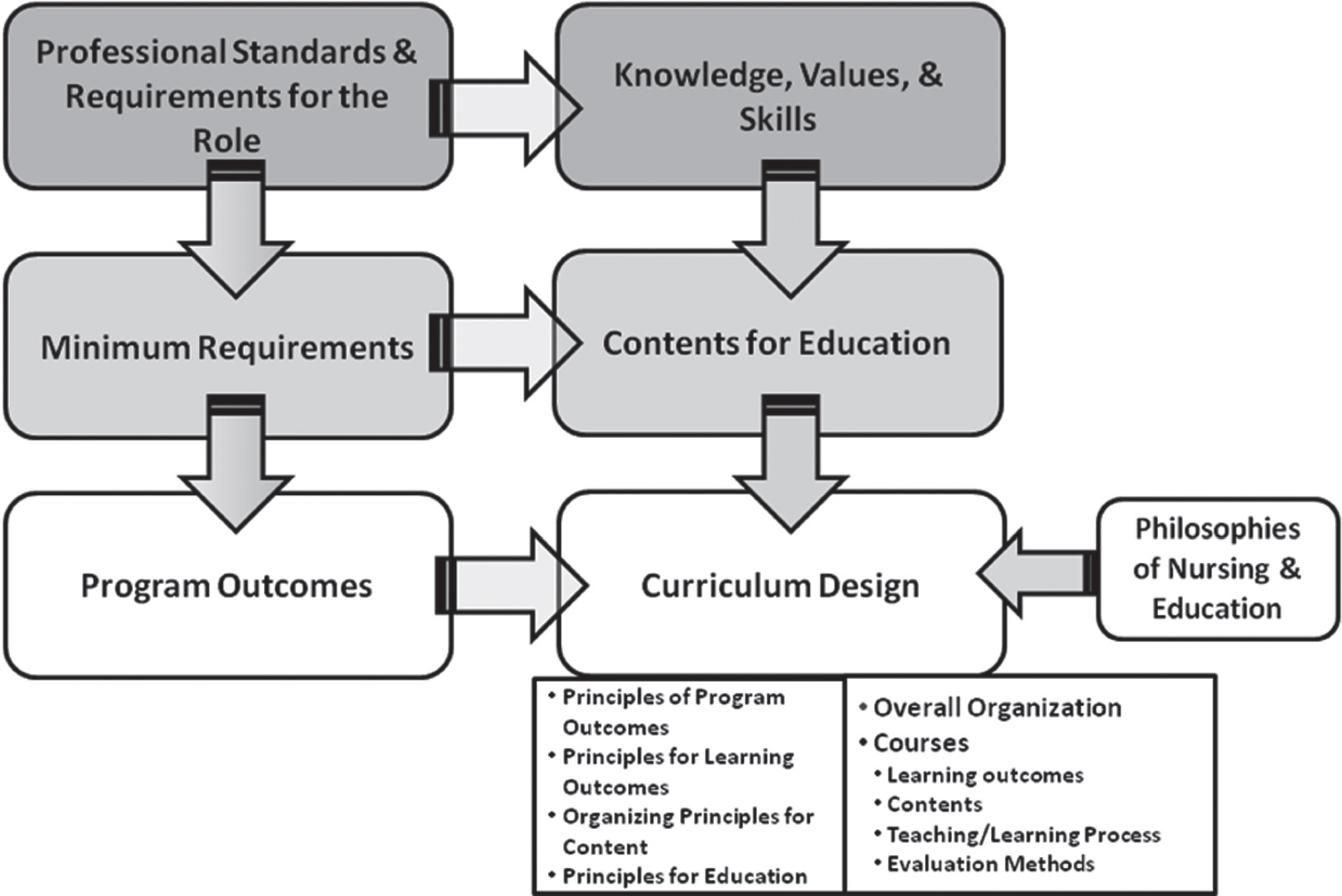
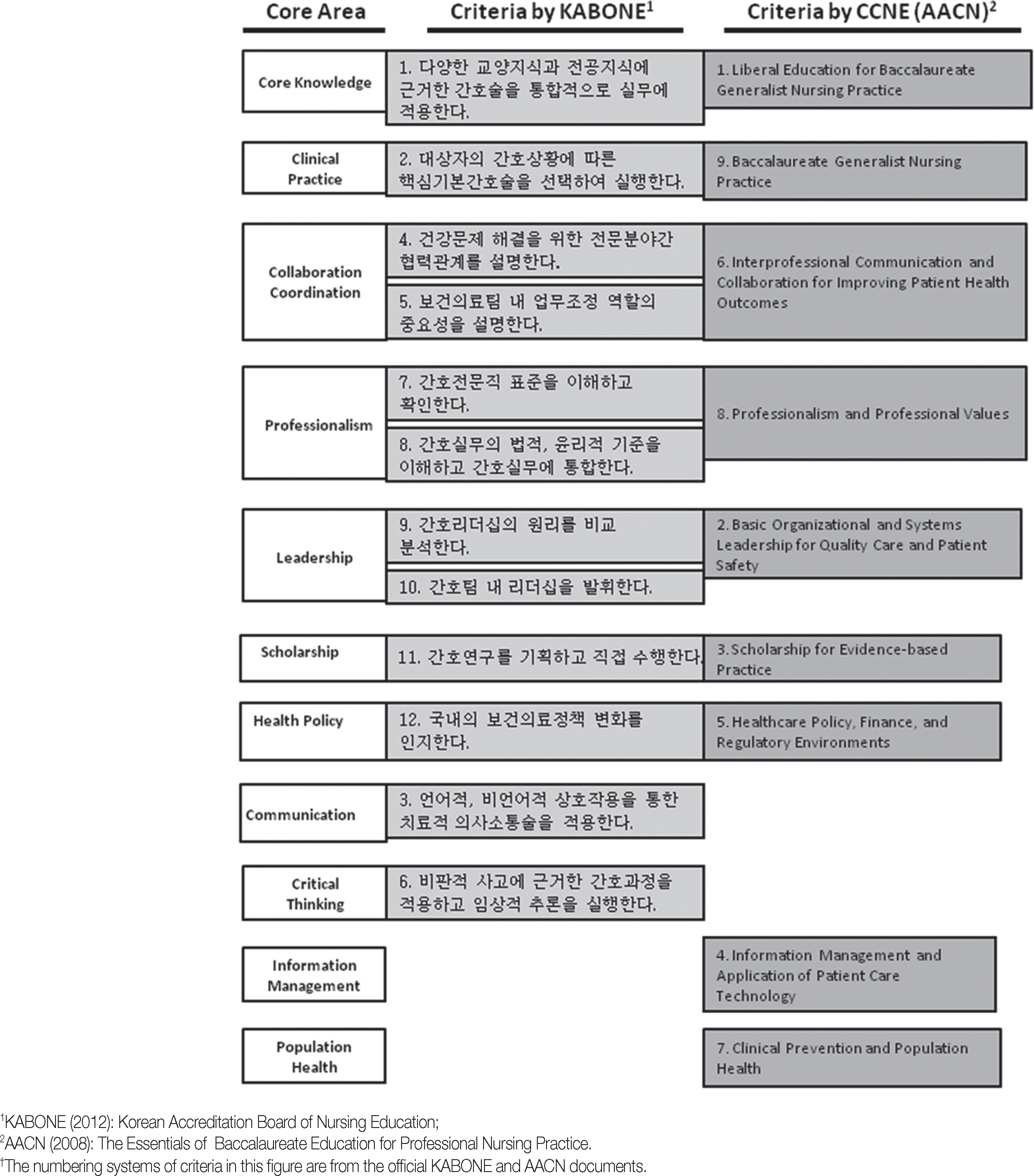
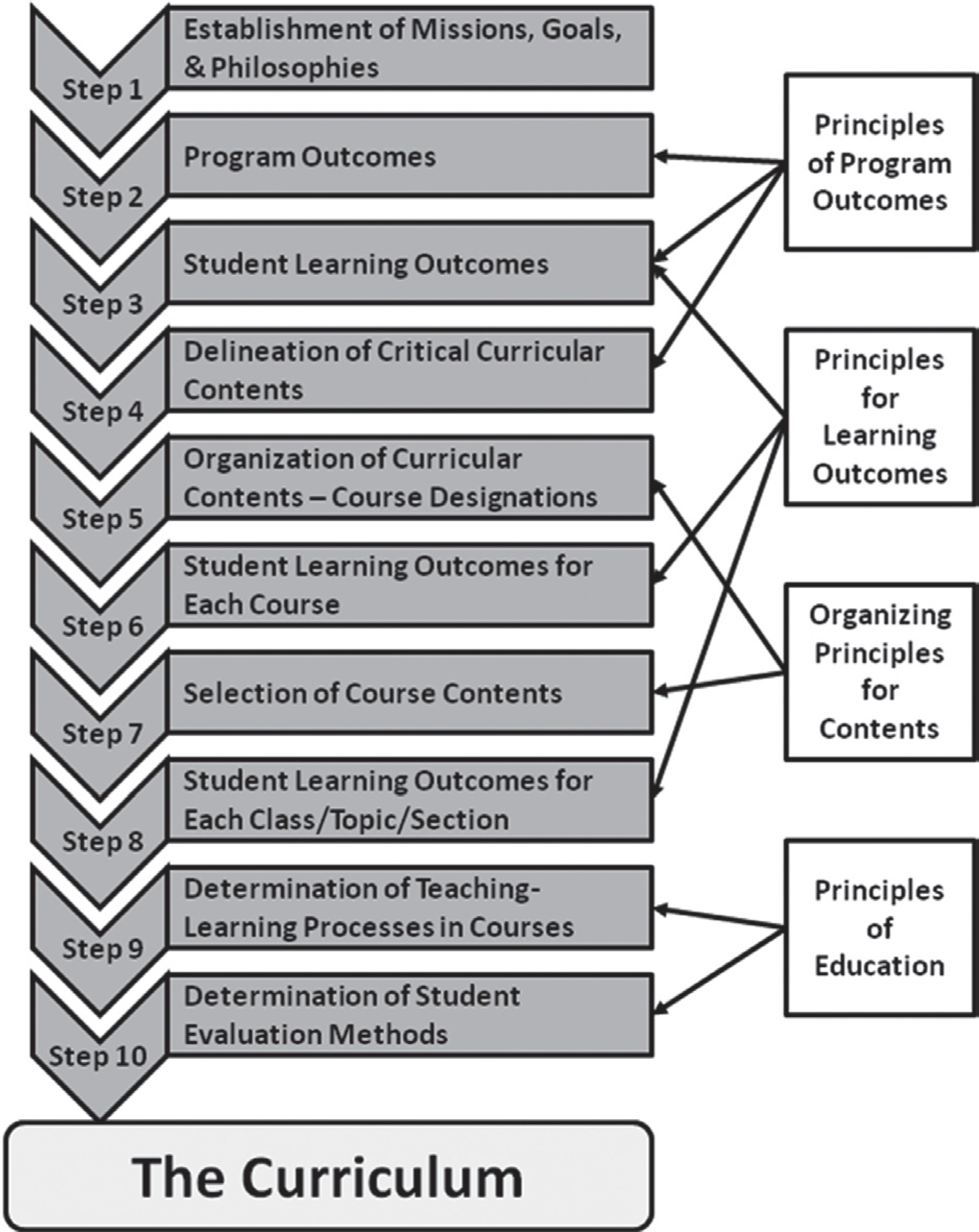


Figure 1. An outcomes-based curriculum development model.
Figure 2. Comparison of the standards for curriculum development in nursing by KABONE & AACN.
Figure 3. Process of curriculum development.
Figure 4. The frame of curriculum development representing the standards of Commission on Collegiate Nursing Education.
Figure 5. A matrix (an example) for delineation of critical contents for nursing curriculum applying a system of content type.
Figure 1.
Figure 2.
Figure 3.
Figure 4.
Figure 5.
Outcomes-based Curriculum Development and Student Evaluation in Nursing Education
 KSNS
KSNS
 E-SUBMISSION
E-SUBMISSION



 Cite
Cite

